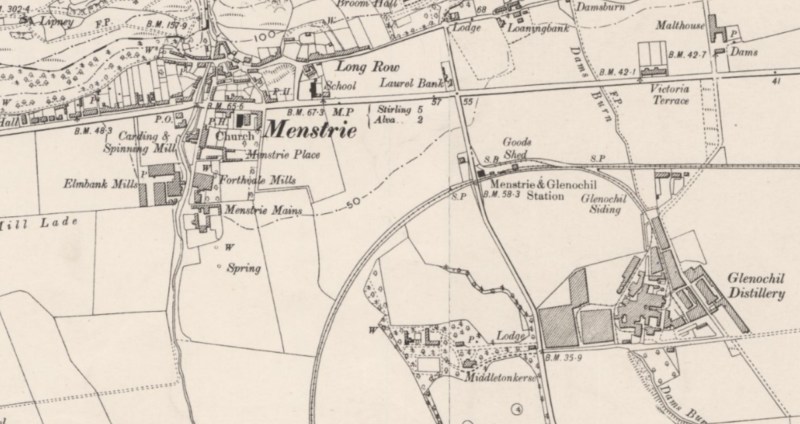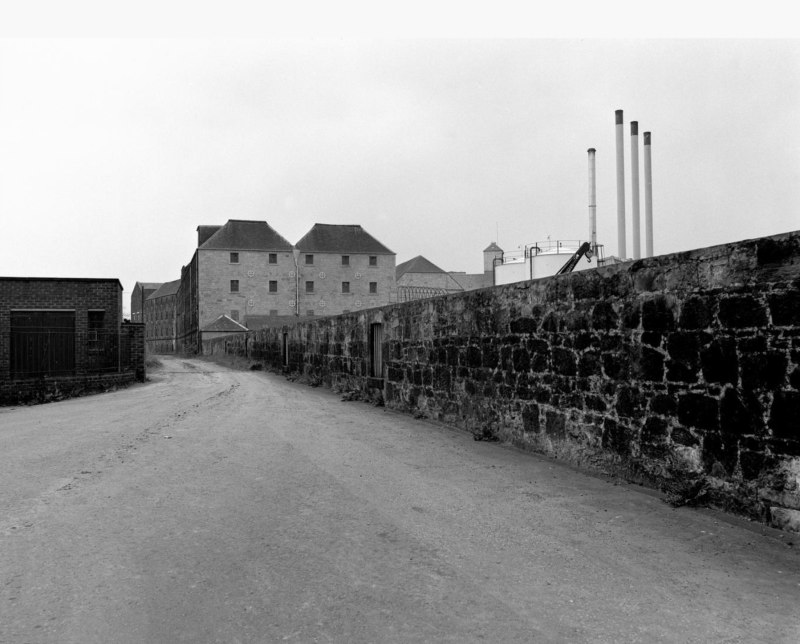The Lowland region Glenochil Distillery, originally called Dolls Distillery, was opened in 1746, just a year after the '45 Jacobite rebellion, on the site of Dolls Farm, to the east of Menstrie. Built beside the Dams Burn, it produced malt whisky, taking barley from the East and West Doll Farms. The site continued to produce whisky until the 1920's.
Dolls Distillery
1746 - James Guild leases land from the Schaws of (Old) Sauchie, builds Dolls Distillery and starts malt whisky production.
1759 - James purchases some of the leased land.
1772 - Farm and distillery lands bought outright.
1784 - James Guild had given tenancy of parcels of the land to his sons, John, William, James and Walter. James, his third son, had been given the lands at the Doll Farm and the distillery. However, the land and distillery is lost when bankruptcy came later in that same year, after the harvest fails for third year in a row. The land and buildings were sold to James Johnstone of Alva.
1785 - The Dolls Distillery is re-opened by John Philp. He was a cousin of the Steins, of Kilbagie and Kennetpans, who owned several distilleries. Thanks to their help, John managed to keep the distillery going.
1791 - John Philp was married to Janet Haig, the daughter of John Haig and Margaret Stein, on 21st October 1791 and the couple went on to have four children. Janet's sister Margaret Haig was married to Alloa man John Jameson, who went on to found Jamesons whiskey in Ireland.
1795 - The company was named John Philp & Co.
1798 to 1799 - The Distillery is recorded as having produced 22,977 gallons of spirit in the six months to February, 1799.*
1799 - A Boulton & Watt steam engine was installed and licensed to John Philp & co., Distillery and Corn Mill, Dolls, between September and December 1799. It was a 10 horse power double-acting sun and planet engine, with a 17 2/3 inch cylinder, 4 foot stroke, and parallel motion.
1821, July - Dolls Distillery is reported to have a Wash Still size of 991 gallons, and a Low Wines Still size of 868 gallons, producing 19,808 gallons of spirit between 10 Nov. 1820 and 10 Feb. 1821.**
1827 - John Philp dies.
1832 - John Philp's son Andrew withdraws from the business, leaving his other son John, in control of Dolls. Andrew buys Grange Distillery in Alloa.
1834 - Dolls Distillery renamed West Dolls Distillery.
1846 - Dolls Distillery is sold.
1849 - John Philp & Co become bankrupt.
Glenochil Distillery
1846 - In 1846 West Dolls Distillery was acquired by MacNab, Brother & Co., who rebranded it as the Glenochil Distillery.

OS map 1861
MacNab changed the site from a malt distillery to a grain distillery in 1846, removing the pot stills and installing a Stein still in their place. The Stein still was licensed on 1st December 1846. A second grain still was added later.
1851 - Accident: extract from Alloa Advertiser, December 27, 1851.
- Deplorable Accident
- On Thursday last a very distressing casualty occurred at Glenochil Distillery. One of the workman Alexander Maule went into the steam room full of steam and was dreadfully scalded. The poor man was got out and lived in agony until 10pm in the evening when death terminated his suffering.
1870s - Commercial yeast production was developed on the site and continued to expand.
1877 - The MacNab company become one of the founder members of Distillers Company Ltd. (DCL) on its formation in 1877.
This company's origins lie in a trade association known as the Scotch Distillers' Association formed by Menzies, Barnard & Craig, John Bald & Co., John Haig & Co., MacNab Brother & Co., Robert Mowbray and Macfarlane & Co. in 1865.

OS Map 1899
1880s - By the 1880s the distillery was huge, producing around a million gallons of grain whiskey per year at its peak, making it one of the most productive distilleries in Scotland at the time. Similar to Cambus, It had its own railway sidings, these off the Cambus to Alva railway spur.

Glenochil Distillery rail sidings - internet picture.
In 1885, Alfred Barnard was charged with the task of visiting and reporting on every active whisky distillery throughout Scotland, England and Ireland. In his resulting book, published in 1887, called "The Whisky Distilleries of the United Kingdom", he says the following of Glenochil.
"Our steps were first directed to the huge Grain Stores, lofty buildings eleven in number, each 120 feet long by 80 feet broad. In front of these Stores is a railway siding direct from the main line to Alloa, which brings the trucks laden with grain to the doors, where their contents are emptied into a hopper, and delivered to the top floors of the Stores by elevators. From thence the grain is conveyed by a continuous screw along the roof of the building for nearly a quarter of a mile, into whichever Store is desired in this way 1,000 quarters can be emptied daily. Contiguous to the Stores is the hot air Kiln, capable of drying two hundred quarters in 24 hours, from whence the dried grain is conveyed by screws and trap doors and received into an elevator, from which it is transmitted by other continuous screws to the Mill stones, where it is pulverised into flour and again passed by screws and elevators to the Mashing department, where it is collected and weighed into bags of 168 lbs. each. These are afterwards emptied into the Mash Tun, a large vessel 20 feet in diameter and 12 feet deep, having the patent revolving stirring gear inside. The liquor from this vessel is now let down on the malt in the Mash Tun below, which is of the enormous measurement of 30 feet in diameter and 7 feet deep, with the usual revolving stirring gear. From here it is drawn off by cranes into the two Underbacks, each 12 feet by 24 feet, and 4 feet deep, and then pumped up by centrifugal pumps to the Cooling Machines, and to three of Morton’s largest refrigerators, where it is cooled to the required temperature prior to fermentation. The Wash is now put into the Fermenting Tuns, of which there are a great number placed in an extensive building, where it goes through the process of fermentation. The carbonic acid gas given off during this process is highly dangerous to the workmen in the lower part of the Tun Room, the gas being much heavier than ordinary air. The building, however, is freely ventilated, and the men only remain a brief time when washing out the building and watching the process.
After the fermentation is complete the liquor is transferred through closed pipes, into the Wash Charger, a vessel containing upwards of 30,000 gallons, and from thence into the Coffeys Patent Stills, which differ from the old Pot Stilling in that they are more economical, and are capable of making a purer spirit. The fusel oil, which forms a proportion of every kind of grain, is by this process completely separated from the spirit and collected into a vessel specially designed for that purpose, and emptied at the and of a period. It may here be mentioned that the oil is a valuable commodity, being used, not only for illuminating and chemical purposes, but, after undergoing a patent process of rectification, is converted into a most useful medicine.
The hot spirit in passing from the Still near the top goes to the Condenser, is cooled in the usual way, and afterwards runs into the two Spirit receivers, each holding about 5,000 bulk gallons. Here the charge is taken, and the Spirits are pumped into the vats, placed in the Spirit Stores, where it is run into Casks, branded and sent into the Warehouses, of which there are seven covering about three acres of ground and all under one roof. They have a very imposing appearance from the road, and are so arranged that carts can drive down the various avenues and deposit or fetch away the Whisky.
We next retraced our steps to the Malting department, where there are three Barley Stores, conveniently arranged buildings each 120 feet long by 60 feet broad. The Barley is carried to each floor by a powerful hoist and dropped through sluices on to the three malting floors. In close proximity is the Malt Kiln, 24 feet by 45, a lofty apartment and floored with perforated steel plates.
The Malt Stores are of great depth. Here when the Malt is taken from the Kiln, it is laid until the building is full, and then put into another Store of the same size until that is filled, so that whilst the contents of the one is maturing, the other one is in use.
We then proceeded to the Mill, a capacious building of several stories, which contains seven pairs of stones for crushing the dried grain and pulverising the Malt.
Our guide next led the way to the Engine department, which contains six engines from 5 to 50-horse power, and six steam boilers about 24 feet long by 7 feet in diameter.
The Company manufacture an enormous quantity of what is called German Yeast, considered superior to that manufactured on the Continent, and which commands a good price in the market.
Within the works there is a large Cooperage for the repair of casks, also carpenters, engineers and blacksmiths shops. Upward of 100 persons are employed in the Distillery, and there are seven Excise Officers on the premises.
The Whisky made at this establishment is pure Grain and is said to be of superior quality, and the annual output is nearly 1,000,000 gallons."

Glenochil Distillery - Pic. Canmore
The distillery part of the operation continued via Distillers Company Limited until production was ceased there in 1929.
Yeast Research and Yeast Production
Yeast, initially a by-product of whisky fermentation, had gradually become the main product and went for manufacture of whisky and bread. Soft water, locally available, is still useful. An extensive bonded warehouse area remains for storage of whisky as it matures in barrels before bottling, while bakers' yeast has given way to fermentation products derived from yeast.
The site at Menstrie remained an important research and production centre for the DCL company until quite recently. The whisky and yeast businesses are now operated by separate companies, namely Diageo, (successors to Distillers Company) and Kerry Group. The latter conducts product development as well as yeast manufacturing.
Today many of the original buildings have been re-purposed or replaced.
References:
Whisky-news.com
The Whisky Portal
wormtub.com
wikitree.com
* Report of the Commissioners of Excise in Scotland., 27th February, 1799.
** Parliamentary reports from Committees, July 1821, Vol VII.
Canmore.org.uk
Maps.nls.uk
The Whisky Distilleries of the United Kingdom - Alfred Barnard (1887).
